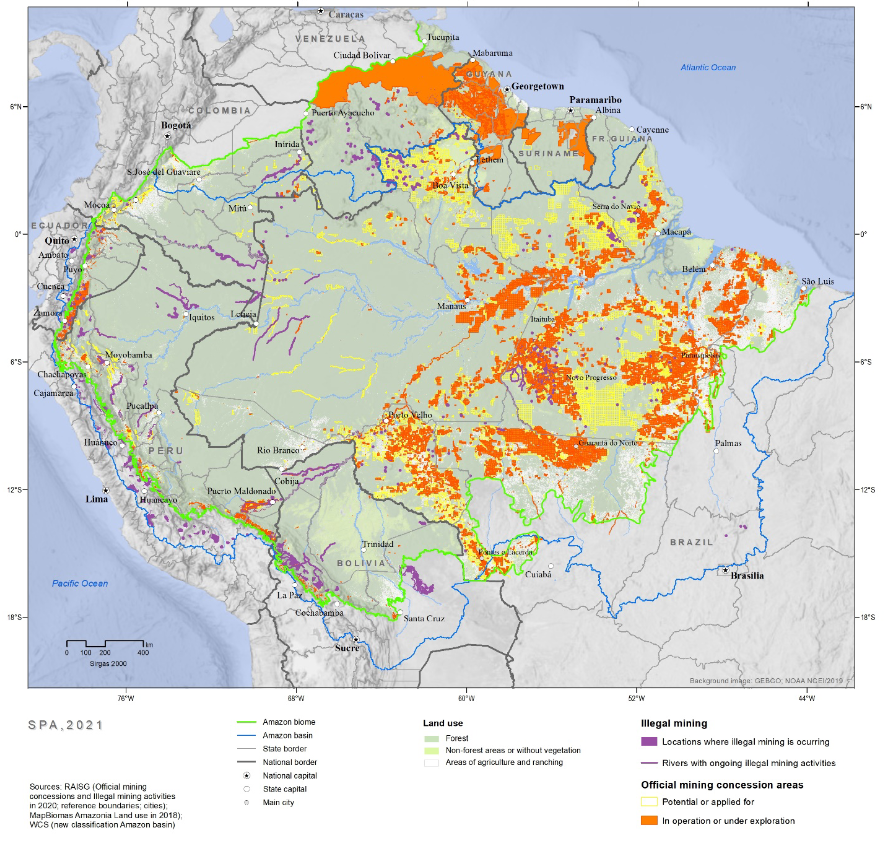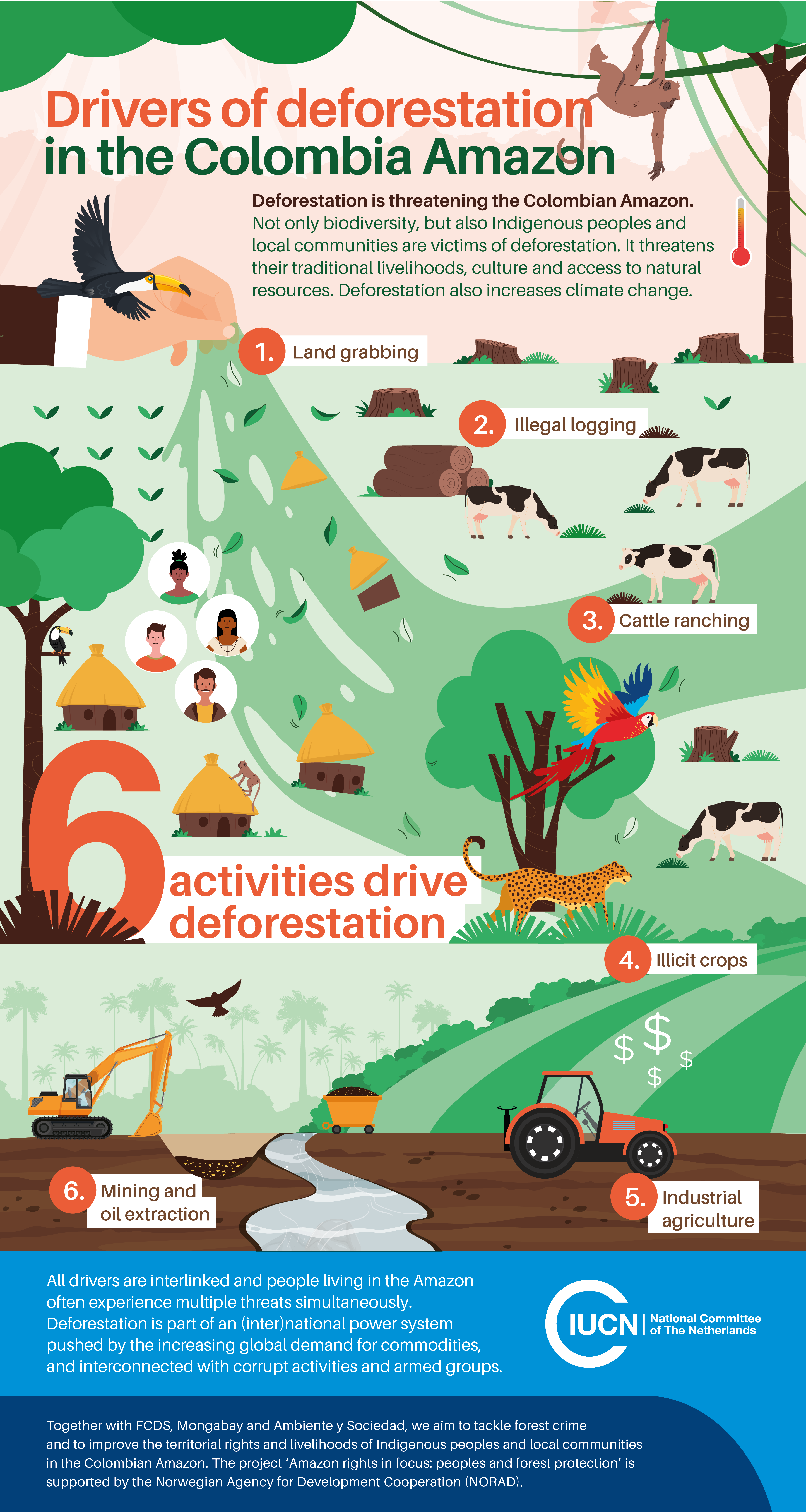This is what the economy of the Amazon…
10 July, 2024
Tuesday 05 december 2023
Text: María Molina
Header photo: © Mariel Cabero/ IUCN NL
The Amazon, renowned for its biodiversity, harbors substantial reserves of oil, gas, and minerals. Throughout the Amazon countries, multinational corporations, particularly those operating in Brazil, Peru, Colombia, Ecuador, and Bolivia, spearhead extensive exploitation of these natural resources. Their activities have a major environmental and social impact[1]Cepal y Patrimonio Natural. (2013). Amazonia posible y sostenible..
According to the World Resources Institute, large scale mining concessions in the Amazon region cover an area of approximately 1.3 million square kilometres. It is estimated that 45 percent of this area is being actively exploited, while the remaining 55 percent is classified as pending areas awaiting procedures for the start of activity or open to bidding. Numerous Indigenous territories are affected by the presence of multiple overlapping permits of mining corporations. It is estimated that an area of approximately 57,000 km2, equal to over 10 percent, overlaps with Indigenous land[2]World Resources Institute. (2020). Undermining Rights: Indigenous Lands and Mining in the Amazon..
Mineral reserves of the Amazon include gold, bauxite, copper, coltan, uranium, zinc, coal, gem stones, and building materials[3]Finer, M. et al. (2015). Future of oil and gas development in the western Amazon. Environ. Res. Lett 10, 24003.. It is estimated that industrial mining concessions cover more than 18 percent of the total area[4]World Resources Institute. (2020) Undermining Rights: Indigenous Lands and Mining in the Amazon.. Spreading though the entire region, the oil and gas projects in the extreme west of the Amazon Rainforest currently cover 733,414 km2. In Colombia, a large part of these activities takes place in the departments of Putumayo, Caquetá and Meta[5]Mining Technology. 2018. Mining’s big environmental footprint in the Amazon..
Article continues below map.

Between 2001 and 2018, more than 400,000 hectares of forest were destroyed in Colombia. This concerns both direct and indirect deforestation through the construction of associated infrastructure, such as the mining camps and (illegal) roads.
According to research conducted by World Resources Institute (2020), banks and international investment funds have financed hydrocarbon extraction projects with great economic profit. It is estimated that extraction activities take place in 450,000 km2 of Indigenous territories, affecting 31 percent of their land. Exploitation rights are often granted to foreign companies frequently ignoring the rights of local communities. ‘Governments own mineral resources, Indigenous peoples cannot prohibit the entry of miners who have government permits, nor can they fully access the minerals in their territories,’ says Patricia Quijano Vallejos, co-author of the study.
The report also indicates a relationship between deforestation and mining. In Colombia, the researchers observed Indigenous territories where mining activities takes place present a deforestation rate twice as high as those without mining. Between 2001 and 2018, more than 400,000 hectares of forest were destroyed. This concerns both direct and indirect deforestation through the construction of associated infrastructure, such as the mining camps and (illegal) roads. This kind of infrastructure paves the way for other extractive activities that further drive deforestation[6]International Crisis Group. (2021). A Broken Canopy: Deforestation and Conflict in Colombia..
In the Colombian Amazon, mineral and oil exploitation takes place legally and illegally. Large-scale concessions are mostly granted to foreign companies. Only in 2018, 188 mining exploitation titles were registered for 122,571 hectares in mainly the departments of Guainía, Caquetá, Putumayo and Guaviare[7]Sanabria-Cuervo, P. – CODS. (2021). Minería, una amenaza latente para la Amazonia..
The number of applications increases year after year in areas that should be protected. Actors exploiting the Amazon resources illegally make use of heavy machinery in the forest and its rivers to open new fronts for extraction. Both the increase in applications for concessions and illegal activities generates distress within Indigenous and peasant communities, displacing local artisanal miners who have historically utilized traditional, small-scale methods across[8]International Crisis Group. (2021) A Broken Canopy: Deforestation and Conflict in Colombia..
Alluvial mining is used to obtain gold in the Amazon basin and the Atabapo, Inírida, Apaporis, Yarí, Caquetá, Putumayo, Puré, and Cotuhé rivers. With this technique, (parts of the) river bed is removed to search for gold or gem stones. Especially when heavy machinery is used, alluvial mining affects the physical and chemical characteristics of water and riverbeds. In addition, the use of toxic substances, such as mercury, poisons the ecosystem and damage the water source of the people in the area[9]UNODC. (2021). Explotación de oro de aluvión. Evidencias a partir de percepción remota 2020..
New studies reveal concerning levels of mercury exposure among individuals from the Miraña and Bora Indigenous communities[10]Cambio Colombia. (2022). La maldición del rey Midas.. The Colombian government prohibited the use and import of mercury in 2021, leading to the rise transnational illegal trafficking networks selling Mexican mercury on the black market in Peru, Bolivia and Colombia[11]WWF. (2020). ¿De dónde viene el mercurio que envenena la Amazonia?.
For years, Colombia has been one of the countries with the highest number environmental defenders killed. Worldwide, mining and extractives form the second sector linked to deaths of defenders
Because mineral mining and oil extraction are very lucrative businesses, even more than cocaine[12]InSight Crime & Igarapé Institute. (2021). La minería ilegal en la Amazonía colombiana. (2021)., armed groups have been controlling the exploitation zones and have become investors, leading to acts of violence and intimidation.
Both legal and illegal exploitation of the Amazon’s natural resources, however, are a threat to the safety of the region’s inhabitants. Indigenous communities have responded to these threats by demanding the protection of their territories from extractive activities, for example in the Yaigojé Apaporis Reserve[13]Gaia Amazonas. (2019). Todos vamos en el mismo bote: Historia del Resguardo – Parque Yaigojé Apaporis.. The Siona community has organised to defend their ancestral territories from multinationals and organised crime groups that seek participation in these businesses[14]Cruz, R. – Verdad Abierta. La larga lucha de los Siona en defensa de su territorio ancestral..
But defending these territories comes with a high price. For years, Colombia has been one of the countries with the highest number environmental defenders killed. Worldwide, mining and extractives form the second sector linked to deaths of defenders[15]Global Witness (2022). Decade of defiance: Ten years of reporting land and environmental activism worldwide..
Their and other efforts do lead to small steps forward. In 2021, the Colombian Congress reported an initiative seeking to prohibit oil exploitation in the country’s Amazon region, but up to date there are no indications of its approval[16]Tarazona, D. – Mongabay. (2022). Colombia: ¿Qué implica el fallo que restringe la minería en zonas de importancia ambiental?. In 2022, the Colombian Council of State decided to review mining activities carried out in areas of environmental importance, thanks to the work of more than seven years of civil society organisations.
But even though the current government has presented a new proposal to declare temporary protected areas to avoid the granting of new concessions in sensitive natural areas, the exploitation rights granted before the application of the proposed law remain.
IUCN NL works with La Fundación para la Conservación y el Desarrollo Sostenible (FCDS), Ambiente y Sociedad and news platform Mongabay to protect the Colombian Amazon and the rights of the Indigenous peoples and local communities inhabiting this important region.
In our series ‘Drivers of deforestation in the Colombian Amazon’ we analyse the different causes of deforestation in the South American country. This article on mining, oil and gas extraction is the final publication in the series.



